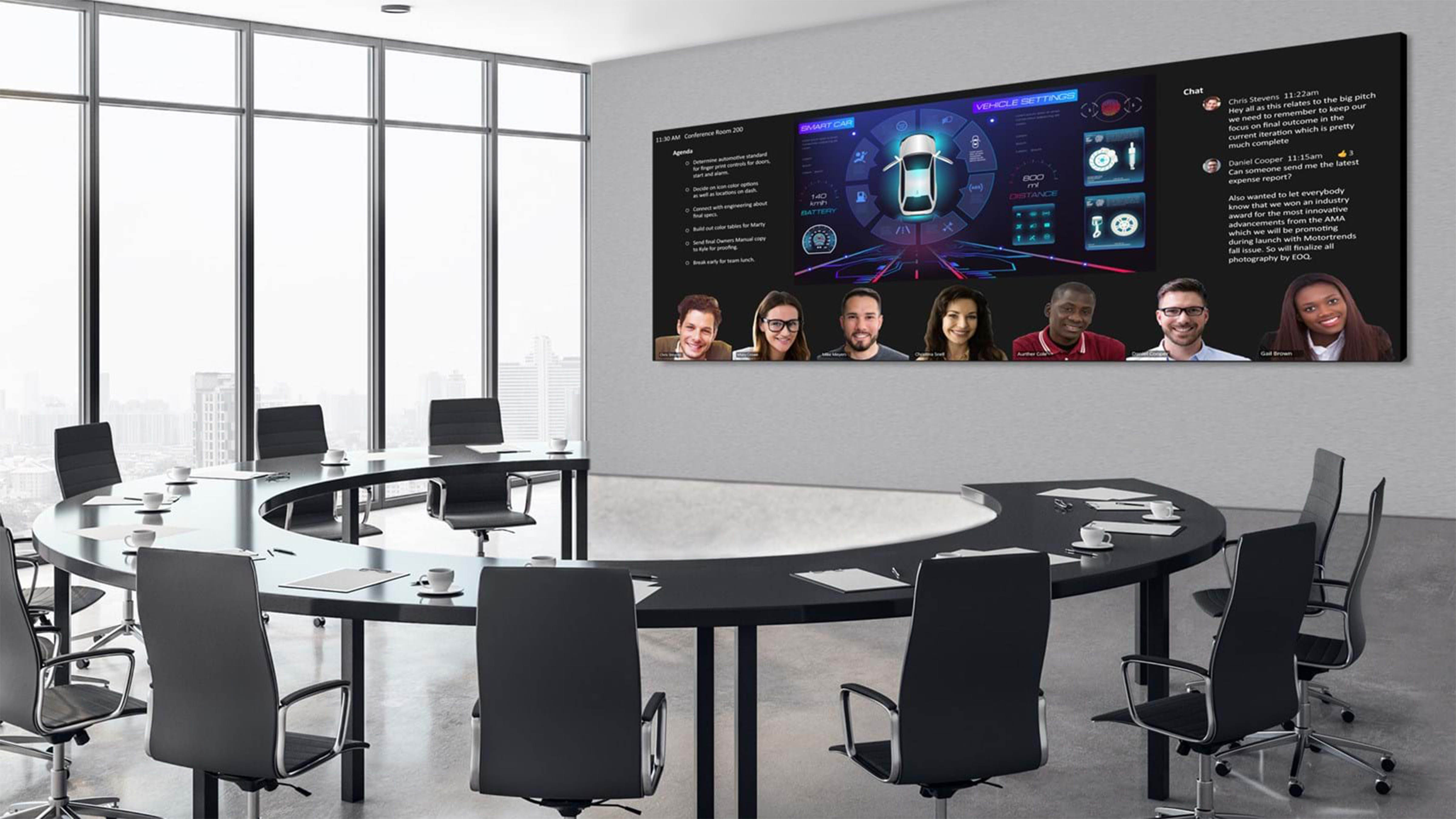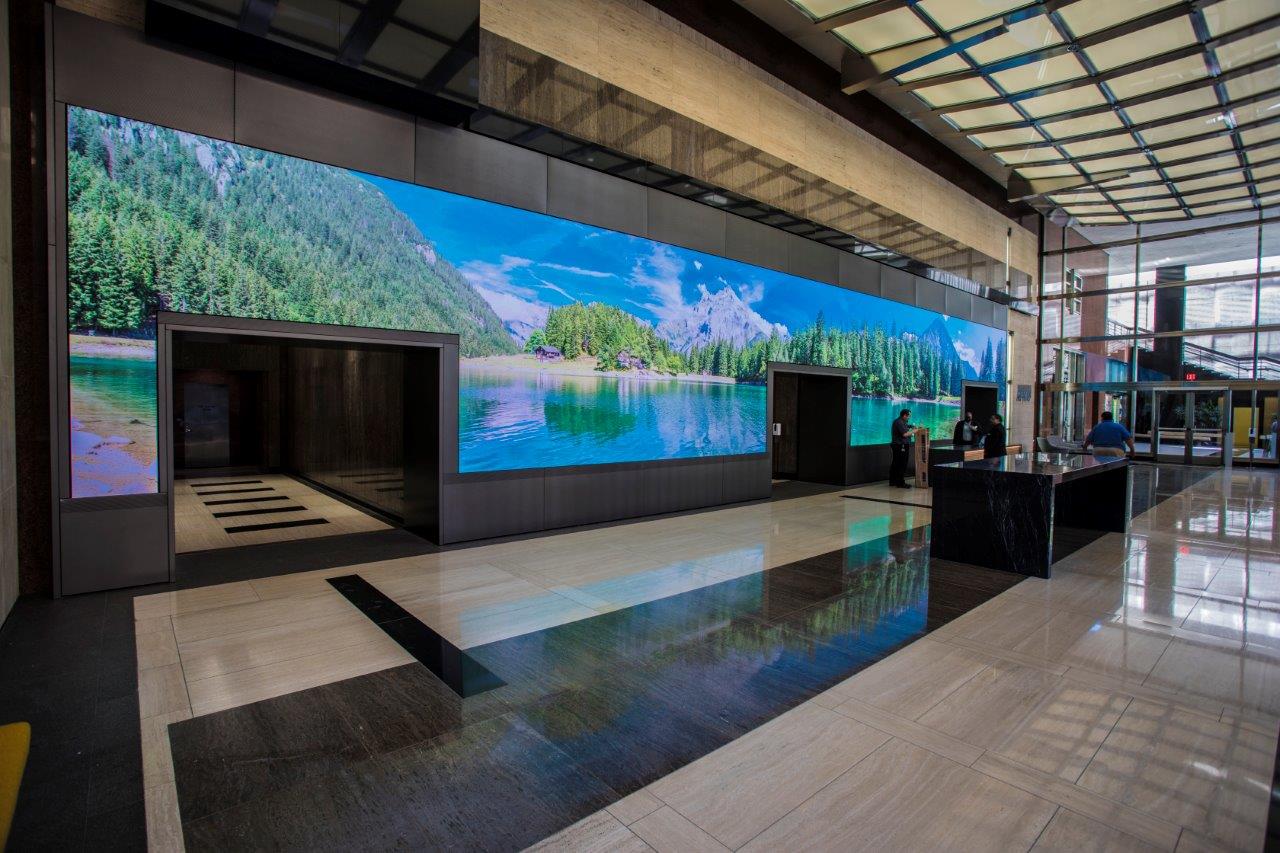Why Go Wide with dvLED Displays?
New aspect ratios can be ideal for today's hybrid workspaces.

With today’s strong emphasis on reimagined workplaces, companies are embracing new technologies that power collaboration with colleagues near and far as well as improve workflow efficiency. This includes direct-view LED (dvLED) video wall technology—and there are fundamental reasons why these products are being used by enterprises so extensively.

In addition to delivering unmatched performance and flexibility to create seamless, vibrant, long-life displays of any size or shape, dvLED displays also come in a wide range of pixel density and price point options and allow for simplified maintenance. As a result, today’s LED video wall solutions are reinventing the way businesses operate daily.
In a July 2022 OMDIA report covering the LED video display deployment for North America, the industry analyst is forecasting fine-pitch LED year-over-year growth rates of around 35 percent for this year.
Screen Real Estate
21:9 and 32:9 aspect ratio configurations are emerging, providing the opportunity to broaden the viewing area, observe multiple content sources at a time, boost productivity, and create an overall more immersive experience. This is especially true for facilitating authentic and engaging videoconference experiences between remote participants and in-room colleagues.
In many cases, rooms in even the nicest buildings can have height constraints that limit the size of a video wall installation. 21:9 and 32:9 aspect ratios are a great way to get more screen real estate by filling the horizontal wall space in a room. These aspect ratios also support standard 16:9 content windows, allowing virtual interactions and presentation materials to fit easily and more naturally within the borders of wide-view video walls.
[Rust Never Sleeps ... and Neither Do Display Manufacturers]
Some video walls today include built-in software or front-end video processors, which means users can switch between different layouts of visual content across the video wall canvas. This includes centered 16:9 presentation to neatly arrange data, as well as A/B side-by-side content viewing to support simultaneous analysis and discussion. Keep in mind that these configurations can sometimes take place automatically via content sensing or be selected by users via touchpanel.
A daily selection of features, industry news, and analysis for AV/IT professionals. Sign up below.
The wide-view aspect ratio also better accommodates videoconferences in which a large group of collaborators are joining from one remote boardroom. Plus, a wider apsect ratio provides more real estate to accommodate a larger number of boxes of individual participants during virtual meetings.
Outside of wider aspect ratios, large dvLED video walls are giving organizations a platform for branding and storytelling, brainstorming and learning, and elevating the workplace experience. This includes applications spanning CEO boardrooms, meeting spaces, employee and members lounges, security operations centers, and corporate lobbies.
Flexibility and versatility are two of the greatest advantages of LED video walls, because they open a range of creative implementations not previously possible.
For example, when one of the largest grossing law firms in the United States and globally needed an LED video wall solution that would complement the sophisticated, modern design of its premier office space, it added two large LED video walls side-by-side in the lobby. Measuring nearly 26-feet-long, 11-feet-high in a 13x10 configuration and nearly 22-feet-long, 11-feet-high in an 11x10 configuration, the installations make a powerful impression when entering the space, while paying tribute to the firm’s corporate culture, which emphasizes employee happiness. With a 1.2 mm pixel pitch, the video walls are multipurpose, supporting live events, presentations, digital conferences, and more.
Within Reach
While still a significant investment, dvLED video walls are increasingly becoming more affordable. As with any new technology, growing demand and ongoing advancements give way for a wider selection of products that eventually come with a smaller price tag.
[Editorial: A Tale of Two TVs]
The cost of an LED video wall solution will vary greatly by factors such as size, pixel pitch, and features—but today, manufacturers are offering fine-pitch LED video wall displays that deliver seamless, high-resolution visual experiences at a price similar to tiled LCD video walls. This makes technology upgrades possible for customers who are budget-conscious or perhaps looking to add seamless LED display technology to their workplace for the very first time.
It's also important to note that a display manufacturer’s warranty program or managed service offering can help alleviate concerns or even simplify the buying process. Looking for a program that provides a customer with control and flexibility to meet their individual requirements or adjust as needs arise is key for finding the perfect solution as well as an experience that offers peace of mind.
Streamlined Installation and Service
For companies who are new to dvLED, it’s likely questions will arise about installation and maintenance. A manufacturer’s relationship with systems integrators and resellers is critical, as well as the manufacturer’s own regional service technicians, who can assist with installation, training, and ongoing support. Exploring the full range of resources available with your dvLED investment will help ensure that it’s well-positioned to deliver captivating and impactful viewing experiences for users.
Service features such as front-side module replacement, in-country repair, and technical expertise are important factors. Additionally, bundled offerings that arrive ready to install and equipped with everything customers need for successful video wall deployment can significantly reduce the time, complexity, and cost. This can span everything from LED display cabinets, spare modules, cables, and wall mounts to remote power supply, remote control, and a video controller.

It's also worth noting that coating can be applied to today’s display products to deliver protection and added durability. This kind of ruggedization is particularly important in high-traffic, casual contact environments, as well as applications that include touch interaction.
In the case of installing dvLED video walls outdoors, many products offer game-changing features designed to withstand weather conditions. With waterproofing, wear-proof masking, dust-tight enclosures, mesh for low wind resistance, and UV protective treatments, organizations can maximize viewing experiences while extending the life of a product and saving money on premature repairs or replacements.
Best Practices in the Office
A key consideration when exploring dvLED video walls for workplace settings is viewing distance. Where will the product be deployed and how will it be used?
If the video wall is being added to a lobby or meeting room, where the viewer will be close to the video wall, a tighter pixel pitch will allow viewers to experience clear imagery without the distraction of discerning pixels. In a setting with greater viewing distance, such as a large auditorium, a larger pixel pitch can be used, delivering comfortable viewing while achieving a lower price point. To facilitate the understanding of these tradeoffs, some vendors provide video wall calculators or configurators on their websites that can help end users work through scenarios.
[The 2022 Integration Guide to Video Walls]
Flexibility and versatility are two of the greatest advantages of LED video walls, because they open a range of creative implementations not previously possible. Designers imagining spaces incorporating curved video walls, column wraps, halos, and other visual designs now have those options.
Some organizations have returned to the office full time, while some are maintaining day-to-day operations from home or adopting a hybrid approach. No matter the situation, wide-view dvLED display technology can play a leading role in fostering next-level collaboration. If something’s missing from your remote videoconferencing experiences—or if it’s time to upgrade the team’s boardroom technology for enhanced data gathering and presentations—there’s an impressive selection of products to choose from that offers something for every need.
Steve Seminario serves as vice president of product marketing for Planar, where he has helped develop and introduce a wide range of leading display products for more than 15 years.

